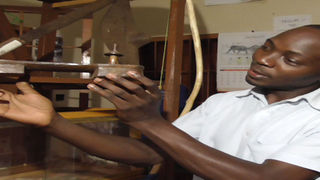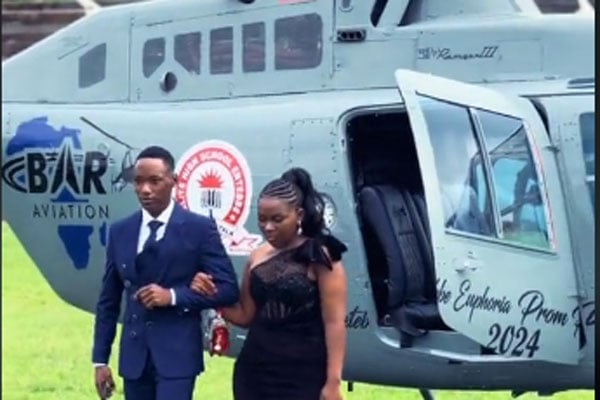
Mr Fred Bwanika, the manager of Buddu Cultural Museum in Masaka, shows off a wooden shoe (Kakalabanda) used by people in the past. PHOTO/BENJAMIN JUMBE
|National
Prime
How Uganda’s museums are punching above their weight
What you need to know:
- Museums play a fundamental role in culture continuity and enjoyment of the right to culture.
St Luke Community Museum splits a two-acre artificial forest in Kiteredde, on Mutukula Road in Kyotera District. The ubiquitousness of trees means that a waft of a gentle wind is sure to welcome the museum’s visitors.
Inside the museum, different cultural artefacts are strategically placed in two exhibition rooms that remain under lock and key if no visitor is entrusted to the care of the curator.
The middle room, which serves as the reception area, has different kinds of paintings and drawings that capture facets about various Ugandan cultures.
Br Fulgensio Ssenyondo, the curator on this particular day, tells us that there “are calabashes, old hoes used by our forefathers, spears and backcloths of different types among many other artefacts” in the room.
Its rich collection notwithstanding, few visitors walk through the museum’s doors. Most of the aforesaid visitors are pupils from neighbouring schools in Kyotera. Br Ssenyondo says the visitors don’t leave the same way they walked in.
“At least people know what a backcloth looks like and how they make the backcloth,” he says, adding, “At least people know what it means.”
There are nearly 25 community museums spread across Uganda. Most of them—much like the one in Kyotera—are relative unknowns.
Take Buddu Cultural Museum in Masaka City. The Buddu County cultural leader, Jude Muleke (pokino), is the first to admit that the museum is anything but vastly popular.
Pokino Muleke says this is rather unfortunate because museums play a fundamental role in culture continuity and enjoyment of the right to culture.
Article 37 of the Constitution of the Republic of Uganda and Article 27 of the Universal Declaration of Human Rights underscore these rights.
“When our children go there they will have to learn, unlearn what is or is not good for their generation,” Pokino Muleke told Monitor, adding, “It is one way of transferring culture from one generation to the next.”
While it is largely unknown, Buddu Cultural Museum is by no means nondescript. Its display of cultural artefacts is impressive by any measure.
Fred Bwanika, the museum manager, says the management’s emphasis and focus on promoting cultural tourism yields dividends. Plans are underway, he further adds, to establish a backcloth-making stall.
“People come here and we show them the tree where we get the backcloth,” he says referring to the Mutuba tree. “All in all, we need to keep people close to their culture.”
Madi Community Museum stands out tall in the West Nile district of Moyo.
LISTEN NOW: Community museum relevance report
Mr Jonathan Agwe, the community museum’s assistant curator, says it has a cross-cultural appeal since there are ties that bind Madi people in both Uganda and South Sudan.
“What we are trying to do is to promote our culture aware that most of the young people are … embracing the western culture,” he reveals, adding, “The reason, therefore, for establishment of this museum is to ensure that the culture started by our grandparents should not go away or should not die.”
To this end, the museum—which opens its doors only thrice a week—has rolled out heritage education and community outreach programmes. Like other community museums, its end goal is to ensure that cultural rights don’t play second fiddle to other rights—be they political, economic and social.
Mr Fredrick Nsibambi, the deputy executive director of the Cross Culture Foundation Uganda, says museums “are very important spaces for Ugandans to be able to access, enjoy and express their cultural resources.”
Constricted envelope
Since they are non-profit entities, most community museums grapple with constricted resource envelopes. The negative attitude of the public toward museums doesn’t help matters. Br Ssenyondo says some people, for instance, associated museums with witchcraft.
“People really have a negative perception about the museum. You find that in a month, the number of people who come to the museum at times will not reach 20,” Mr Agwe adds.
This explains why Bwanika is pushing for special funding for community museums.
In September, Parliament passed the Museums and Monuments Bill, 2022, with amendments. The Bill aims to strengthen administrative frameworks to ensure efficient management of the cultural and natural heritage sub-sector. The piece of legislation has, however, drawn mixed reactions.
Ms Ritah Atukwasa, the Mbarara Woman MP who doubles as a member of the parliamentary Tourism, Trade and Industry committee, says—unlike its predecessor—the new Bill addresses tangible and intangible cultural issues.
“It is very important because history, culture needs to be preserved,” she notes, adding that “it is also a source of income, especially from tourism.”
Sam Kizaalwa, an assistant commissioner of museums in the Tourism, Wildlife and Antiquities ministry, agrees, reasoning that the Bill will strengthen the existing law.
“These museums did not have any law affecting them because they were not catered for at that time … this law comes to streamline this sector,” he says.
He added that players in the current space “will be required to ask for permission to be established as a museum whether already existing or not. They will have to follow formalities as required, they ask for permission, get inspected and given guidelines and requirements to fulfil, and having fulfilled then they will be allowed to operate.”
Provisions in Bill
Clause 26 of the Bill states that the department of tourism may, where a monument of national importance or significance is in danger of being destroyed, compulsorily acquire the monument in accordance with article 26(2b) of the Constitution.
The Bill in clause 24 further states thus: “The commissioner may, where a monument, heritage value or site has been neglected into disrepair by notice, cause the owner, caretaker or responsible body to repair the monument, heritage value or site.”
It also goes on to state that where the owner, caretaker or responsible body for the protection of the monument, heritage value or site, fails to comply with the terms of the notice issued within the specified time, the commissioner may cause the repair of the heritage value or site and recover the costs of the repair from the owner or responsible body.
“I think they need to bring on board people responsible for different places where those artefacts and historical items are found to ensure that they facilitate them,” Pokino Muleke says, adding, “They know better how to preserve them. But now taking over what they think is in danger, I don’t think the government will be able to make it.”
Ms Doreen Katusiime, the Permanent Secretary in the Tourism, Wildlife and Antiquities ministry, says “the law is going to ensure that the sector is regulated.” She adds that “there is no sector which should not be regulated” and that “regulation sometimes is understood by people to think you are trying to hamper growth.”
She notes that the registered community museums will be able to get support from the national museum. The support, she hastens to add, may not be financial as much as it is technical.
Mr Nsibambi, however, reasons that it is not “right” to split the administration of cultural resources—namely the tangible and intangible.
Currently, the tangible cultural resources are being managed by the department of museums and monuments under the Tourism, Wildlife and Antiquities ministry. The intangibles are on the other hand managed by the department of culture and family affairs under the Gender, Labour and Social Development ministry.
Amongst the recommendations by the parliamentary committee on tourism and trade are proposed establishment of a standalone Ministry of Culture responsible for administration of both tangible and intangible cultural resources.
“For us we believe that if we go that way, we will be able to sustainably promote our cultural resources—both tangible and intangible—as represented in the different community museums across the country,” Mr Nsibambi says.
Ms Katusiime on her part says both ministries can still work together to ensure that the Bill—once it is assented to—is enforced. She describes having one ministry as being “ideal.”
Ms Peace Mutuuzo— the junior Gender and Culture minister—has meanwhile assured all people with private or community museums that government is to protect them.
“We cannot make a law that deprives them of their property … [or] discourages them from further development,” she says, adding, “As a ministry responsible for culture, we shall protect the interests of the community museums. No one is going to compel you or take anything by force.”
It is hoped that once the law comes into force, it will be an engine for streamlining the operations of both private and public museums.




